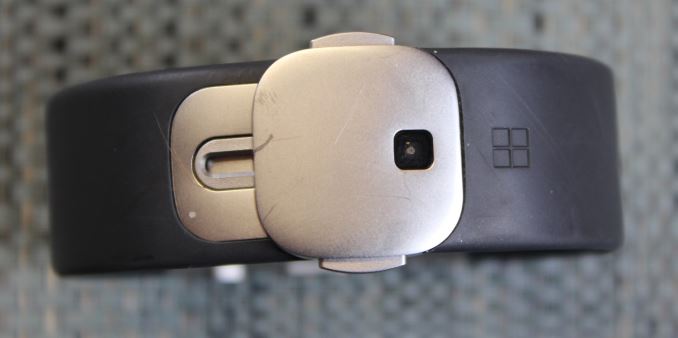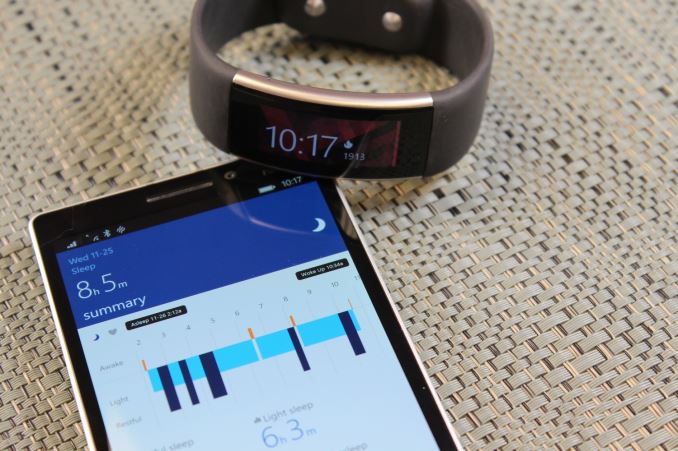The Microsoft Band 2 Review
by Brett Howse on November 30, 2015 8:00 AM EST- Posted in
- Wearables
- Microsoft
- Microsoft Health
- Microsoft Band
Final Words
I think Microsoft has done a great job on improving the Band over the first generation. The styling and comfort levels have gone way up from the black plastic first generation model. The new curved screen is exactly what the Band needed to fit a wrist more easily, and Microsoft took note that many people wore the Band with the screen on the inside, and modified the Band to work better that way. Moving the batteries from the straps to the clasp has also made the strap a lot more comfortable, and the new material is great.
Where the Band excels is in fitness tracking. Fitbit and others have a strong hold on this market, but they don’t have the cloud infrastructure like Microsoft to be able to integrate with other vendors, and to store and manage data as easily. As a fitness band, the Microsoft Band 2 is at the top tier of devices available, with enough sensors to track many metrics. The built-in GPS makes it a great companion for runners, hikers, or bikers, and the generic exercise function is a nice catch-all for pretty much any other fitness activity you want to track. It will estimate your VO2 Max while running, and if you are serious about fitness this is a great device.
It also doubles as a pseudo-smartwatch, with obvious things like a clock included, but it will run apps right on the Band as well. Eventually this is going to be merged into Windows IoT, but for now it’s a custom firmware with custom apps. If this fit into the Universal Windows Platform you could see even more potential, but for now the limited processing power of the Cortex M4 is put to good use with built-in functions that fit well into the idea of the Band, plus third party apps which can expand the capabilities. You can do Smartwatch-style tasks like read and respond to messages, get notifications right on your wrist, and even pay for Starbucks.
It's a pretty limited smartwatch though, with truncated messages and no real sense of a symbiotic relationship with the Smartphone. It’s instead another device, which syncs through the phone but is otherwise standalone. That’s great for running, but it would be great to be able to control music playback on your phone, or to be able to clear notifications on the Band which then clears the same ones on the phone. At the moment it’s further from a smartwatch than I would like.
This kind of speaks to the target audience as well. Really, the Band is targeted to people who are into fitness, and those who want to track their activities. Fitness and I have a love/hate relationship, and wearing the Band becomes a lot less useful when you don’t want to use most of its functions. For those looking for a Smartwatch, they would likely be better suited somewhere else.

At $249, the Band has gone up in price since the first genration’s $199 price, but the redesigned styling and addition of a barometer likely make it worth it, at least for those not already invested in the ecosystem. It’s in the same ballpark of pricing as similar devices that are targeted towards just fitness, so it’s nice to get the extra functionality of the Band as a bonus on top. Microsoft was pretty smart to make this a cross-platform device as well, since their own foray into the mobile world has not been as successful as they would have liked. The Microsoft Band 2 would make a great companion to anyone into fitness or golf, which is really what it is targeted at. Those who are looking for a smartwatch that works with Windows Phone also only have this option, and the capabilities of it are mostly directed towards fitness, where it excels.











56 Comments
View All Comments
zeeBomb - Monday, November 30, 2015 - link
I got bands I got bands!zeeBomb - Monday, November 30, 2015 - link
I always admired the bands Microsoft made. Nice review Brett, definitely on my watch list this holiday season (see what I did there? :p)Fallen Kell - Monday, November 30, 2015 - link
I just personally have a hard time with these bands and smart watches... I mean, until they look like the below, I just can't see myself choosing the smart bands/watches over the real deal:https://omegaforums.net/attachments/2-jpg.39091/
plewis00 - Monday, November 30, 2015 - link
I would say this is pretty damn close:http://www.tagheuerconnected.com/product
kiwirayda - Saturday, December 5, 2015 - link
It should be for Six times the price and not quite the full feature set. Brilliant execution in style and form!JKflipflop98 - Saturday, December 12, 2015 - link
Looks like a big, gaudy chunk of obsolete junk to me.remo_mein05 - Thursday, December 3, 2015 - link
Nice watch..http://theyouthjob.com/?ref=103109nandnandnand - Monday, November 30, 2015 - link
Banned from AbandTechAshinjuka - Friday, December 4, 2015 - link
Soundtrack by Flosstradamus!⚠ ⚠ ⚠ https://soundcloud.com/flosstradamus/b-nned-2 ⚠ ⚠ ⚠
duploxxx - Monday, November 30, 2015 - link
nice features and design but also expensive